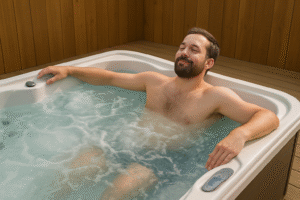Table of Contents - How long to stay in a hot tub for muscle recovery
- Hot Tub After Workout: Perfect Timing for Maximum Benefits [Expert Guide]
- Understanding Hot Tub Benefits After Exercise
- Perfect Timing for Hot Tub Use
- Essential Hot Tub Features for Recovery
- Recommended Hot Tub Products
- Safety Guidelines and Best Practices
- Final Thoughts
- FAQs
- Is it good to use a hot tub after a workout?
- How long should I wait after a workout before getting in a hot tub?
- How long should I stay in a hot tub for muscle recovery?
- What hot tub temperature is best after exercise?
- Can hot tubs help with DOMS (Delayed Onset Muscle Soreness)?
- Is a hot tub better than an ice bath after working out?
- What are the best hot tub features for recovery?
- Can I use a hot tub after weight training?
- What are the hydration guidelines after hot tub use?
- Are there risks to using a hot tub after a workout?
- Can hot tub use help improve sleep after a workout?
- Is it safe for everyone to use a hot tub post-workout?
This blog post may contain affiliate links. As an Amazon Associate I earn from qualifying purchases.
How long to stay in a hot tub for muscle recovery
Hot Tub After Workout: Perfect Timing for Maximum Benefits [Expert Guide]
Ready to supercharge your workout recovery? Here’s something exciting – soaking in a hot tub can match the health perks of a good exercise session! A fascinating 2021 Coventry University study showed that hot tub after workout sessions boost your heart health and fitness levels just like regular exercise does.
Picture this: 20 minutes of pure relaxation that actually speeds up your recovery. Science backs it up – hot tub therapy works better than cold treatments for muscle recovery. The magic happens when warm water opens up your blood vessels, helping your body flush out that pesky lactic acid that makes your muscles sore.
Let’s get you started on the path to better recovery! We’ll show you the perfect timing tricks, ideal temperature settings, and smart ways to make the most of your hot tub sessions. Whether you’re crushing daily workouts or just starting your fitness adventure, you’ll discover exactly how to turn your hot tub into your personal recovery zone.

Understanding Hot Tub Benefits After Exercise
Ever wondered what happens to your body when you sink into warm water after a tough workout? The science behind hot tub therapy is pretty amazing! Your body kicks into recovery mode through several fascinating processes that help those tired muscles bounce back.
How heat therapy aids muscle recovery
Ready for some cool science? When you dip into hot water, your muscles get a special kind of wake-up call! The warmth triggers heat shock proteins that jump into action, helping your muscles rebuild themselves. Plus, there’s this neat thing called MTORC1 that gets super active, helping your muscles repair and grow stronger.
Hot water immersion works like magic for your cells too! It boosts something called somatotropin – that’s your body’s natural growth hormone. Think of it as your personal repair crew, working overtime. The combo of heat and floating weightlessly creates the perfect environment for your muscles to heal.
Impact on blood circulation
Here’s where it gets really interesting! Set your hot tub between 100 to 104 degrees Fahrenheit, and watch your circulation kick into high gear. Would you believe your blood flow can increase by up to 345%? This super-charged circulation:
Effects on muscle soreness
Feeling those post-workout aches? Your hot tub has some tricks up its sleeve! The warm, cozy environment:
- Drops stress hormones by 22%
- Releases your body’s natural feel-good chemicals
- Helps flush out that pesky lactic acid
Those annoying delayed muscle aches (DOMS)? Hot tub therapy has your back! The combo of heat and water pressure works like a gentle massage therapist, helping you recover faster.
Pro Tip: Keep that water temp between 100-104°F and don’t forget to drink plenty of water before and after your soak!
Fun fact: Scientists are finding that hot water might actually work better than cold therapy for keeping your exercise performance top-notch. Plus, there’s a bonus – that warm, relaxing environment helps calm your mind and improve your sleep, which your muscles absolutely love!
Perfect Timing for Hot Tub Use
Ready to make the most of your hot tub recovery? Timing is everything when it comes to hot tub therapy! Let’s discover the perfect moment to take that relaxing dip and help your muscles bounce back faster.
Immediate post-workout window
Hold that thought about jumping straight into your hot tub! Your body needs a little breather first. Scientists tell us that waiting 45-60 minutes after exercise lets your heart rate and body temperature settle back to normal. Think of it as your body’s cool-down party!
Want the best results? Here’s your game plan:
- Take a gentle walk or do some light stretches
- Let your body cool down naturally
- Drink plenty of water
- Keep an eye on your heart rate
Here’s something interesting – a 2021 study found that some athletes got stronger by hopping into hot water just 10 minutes after training. But remember, this isn’t everyone’s cup of tea!
Waiting period for different exercises
Different workouts need different recovery plans. Let’s break it down:
Strength Training
- Let those muscles cool down naturally
- Keep that water bottle handy
- Sweet spot for soaking: 10-25 minutes
Endurance Activities
- Water is your best friend – drink up!
- Give yourself proper cool-down time
- Try mixing hot and cold therapy
HIIT Workouts
- Take extra time to cool down
- Wait for normal body temperature
- Start with quick dips
Want to kick recovery up a notch? Some athletes swear by this hot-cold combo:
- Quick cold dip (55°F for 1-2 minutes)
- Warm up in the hot tub (102°F for 3-4 minutes)
- Repeat 3-4 times
- Finish with cold
Pro Tip: Fighting those day-after aches? Try using your hot tub during the 24-48 hour window when DOMS usually hits hardest.
Remember, your body knows best! Feeling extra tired or super sore? Give it another day or two before your soak. And don’t forget – staying hydrated is your ticket to recovery success!
Essential Hot Tub Features for Recovery
Looking for the perfect hot tub to speed up your workout recovery? Let’s explore the amazing features that turn an ordinary soak into a muscle-healing paradise! From powerful jets to smart temperature controls, every detail matters in creating your perfect recovery zone.
Jet placement and pressure settings
The real magic happens with those targeted therapy jets – they’re like having a personal massage therapist on call! Quality hot tubs pack some serious muscle-soothing power with:
- Core Zone jets that work wonders for your abs and lower back
- Full Body Zone coverage for head-to-toe relief
- Upper Back specific jets for those tough shoulder knots
- Reflexology Zone jets to pamper your tired feet
Pro Tip: Play around with those jet settings! Crank it up for deep tissue work, or keep it gentle when your muscles need a lighter touch.
Temperature control systems
Getting the temperature just right makes all the difference in your recovery. Today’s smart hot tubs let you dial in the perfect warmth:
- 99°F-100°F when you want to just unwind
- 102°F-104°F to really tackle those sore muscles
- 98°F for those longer, leisurely soaks
Water treatment options
Crystal clear water isn’t just pretty – it’s essential for your recovery! Check out these modern treatment options:
Nature’s way with enzyme formulas:
- Keeps things clean without the chemical smell
- Balances pH perfectly
- Throws in some coconut oil to keep your skin happy
Mineral magic systems featuring:
- Silver and copper doing the cleaning work
- Fewer chemicals needed
- Water that sparkles
Recovery-Boosting Hot Tub Picks:
Remember, showing your hot tub some love with regular maintenance keeps those recovery sessions working like a charm. Keep those jets clean, temperature steady, and water sparkling – your muscles will thank you!
Recommended Hot Tub Products
Ready to find your perfect recovery companion? Let’s dive into some amazing hot tub options that won’t just pamper your muscles – they’ll transform your post-workout routine! From grab-and-go portable tubs to luxury spa systems, there’s something for every athlete and budget.
Portable recovery tubs
Need recovery on the run? Check out these portable powerhouses! The Polar Recovery Tub 2.0 Oval™ is turning heads with:
- Pops up in under 5 minutes
- Fits even our tallest friends (up to 6’7″)
- Tough PVC and nylon build
- Try-it-free for 90 days
Want another cool option? The Athletes Large Inflatable Ice/Hot Bath brings some neat features:
- Super-thick 3-inch reinforced PVC
- Keeps temps steady down to temperature maintenance 14°F
- Comfy EVA foam bottom
- Handy dual-action pump
Premium spa systems
Dreaming big? Sundance Spas® pulls out all the stops with:
- Magic-working Fluidix® jets
- Crystal-clear CLEARRAY® UV-C water system
- Mood-setting LED lights
- Body-hugging ergonomic seats
The Jacuzzi® J-LX® Collection? Pure luxury:
- Seven perfectly shaped seats
- Healing infrared and red light therapy
- Heaven for your shoulders and neck
- Space to stretch out
Budget-friendly options
Who says recovery has to break the bank? Meet the Jasonwell Ice Bath Tub:
- Five layers of cozy insulation
- Rock-solid stainless steel legs
- Snug thermal cover
- Quick and easy draining
Recovery Tub Selection Guide
| Feature | Essential | Optional |
|---|---|---|
| Temperature Control | ✓ | |
| Jet System | ✓ | |
| Portability | ✓ | |
| LED Lighting | ✓ |
Pro Tip: Want the best of both worlds? Look for tubs that do hot and cold therapy – your muscles will love the variety!
Maintenance Requirements
| Type | Frequency |
|---|---|
| Portable Tubs | Weekly cleaning |
| Premium Spas | Monthly service |
| Budget Options | Bi-weekly check |
Remember, picking the right recovery tub is like choosing a training partner – it needs to match your style and goals. Whether you’re team portable or premium spa, there’s a perfect match waiting to help your muscles bounce back better.
Safety Guidelines and Best Practices
Ready to make your hot tub recovery sessions both enjoyable and safe? Following proper safety guidelines isn’t just smart – it’s essential for getting the most out of your soaks! Let’s explore the perfect balance of temperature, timing, and hydration that’ll keep you feeling fantastic.
Temperature limits
Here’s something crucial – getting that temperature just right! The Consumer Product Safety Commission has some strict rules about this one – never go above 104°F (40°C). Let’s break it down:
- Sweet spot range: 98°F-104°F
- Expecting moms: Keep it at 100°F max
- Little ones: Stick to 98°F
Pro Tip: Start nice and easy at 99°F, then inch up until you find your happy place.
Duration recommendations
How long should you soak? Here’s your perfect timing guide:
- Toasty 104°F: Quick 15-minute dips
- Mild 95°F-100°F: Enjoy up to 30 minutes
- Kids’ splash time: Just 5 minutes when it’s warmest
Safety Duration Guidelines
| Temperature | Maximum Duration | Special Notes |
|---|---|---|
| 104°F | 15 minutes | Keep a close eye |
| 95-100°F | 30 minutes | Perfect for recovery |
| Children’s Use | 5 minutes | Stay cool and safe |
Hydration requirements
Staying hydrated isn’t just a suggestion – it’s your ticket to safe proper hydration and effective recovery! Harvard’s School of Public Health has done the math:
- Guys need: 13 cups of water daily
- Ladies need: 9 cups of water daily
Essential Hydration Tips:
- Sip before you dip
- Keep that water bottle handy
- Don’t stop drinking after
- Skip the cocktails
Watch out for these warning signs:
- Head spinning
- Racing heart
- Something feels off
- Extra sweaty
At 104°F: Soak for no more than 15 minutes
At 100–102°F: You can soak for up to 30 minutes
Always listen to your body and exit sooner if you feel lightheaded or overheated.Use 99–100°F for a relaxing soak
Use 102–104°F for more targeted muscle recovery
Targeted massage jets for sore muscle groups
Adjustable temperature control
Mineral or enzyme-based water treatment for skin-friendly recovery
Men: 13 cups of water daily
Women: 9 cups daily
Drink before, during, and after your soak. Avoid alcohol and caffeine, which can increase dehydration risk.Soak too soon after intense cardio
Stay in too long at high temperatures
Don’t hydrate properly
Warning signs include dizziness, nausea, rapid heartbeat, or confusion. Exit immediately if any occur.
Pro Tip: Your water needs might change based on your workout, weather, food, and body type.
Ready to turn your hot tub into the ultimate recovery zone? The science is clear – hot tub therapy packs a powerful punch when it comes to helping those hard-working muscles bounce back.
Getting the timing right makes all the difference. Remember that sweet spot – waiting 45-60 minutes after your workout before taking the plunge. Keep the temperature between 100-104°F, and limit your recovery sessions to 15-30 minutes for the best results.
Safety first, always! Stay hydrated, listen to your body’s signals, and pick a tub that matches your recovery goals. Whether you’re team portable tub or premium spa system, you’ve now got all the knowledge you need to make hot tub therapy work for you.
Time to dive in and discover just how amazing your post-workout recovery can be. Your muscles are about to discover their new best friend!
Final Thoughts
Picture this: your muscles relaxing, tension melting away, and recovery happening faster than ever before. That’s the magic of hot tub therapy when you do it right! The science speaks for itself – heat therapy works wonders for those post-workout aches and speeds up your bounce-back time.
Want to unlock these amazing benefits? The secret sauce is in the timing and temperature. Give yourself that golden window of 45-60 minutes after your workout before taking the plunge. Keep the water cozy between 100-104°F, and treat yourself to a 15-30 minute soak. It’s like giving your muscles a mini vacation!
Safety and smart choices go hand in hand with great results. Keep that water bottle close, pay attention to what your body’s telling you, and pick a tub that feels just right – whether it’s a portable wonder or a premium spa system. You’re now equipped with all the hot tub wisdom you need to turn your recovery sessions into something special.
Your muscles have worked hard – they deserve this treat. Time to make hot tub therapy your new recovery bestie!
FAQs
Is it good to use a hot tub after a workout?
Yes! Hot tubs help improve circulation, reduce muscle soreness, and speed up recovery by flushing out lactic acid and delivering oxygen-rich blood to your muscles.
How long should I wait after a workout before getting in a hot tub?
Wait 45–60 minutes to let your heart rate and body temperature return to normal. This helps prevent overheating and supports safe recovery.
How long should I stay in a hot tub for muscle recovery?
What hot tub temperature is best after exercise?
The ideal range is 100–104°F (37.7–40°C).
Can hot tubs help with DOMS (Delayed Onset Muscle Soreness)?
Yes. Hot tubs promote blood flow and reduce inflammation, which can help relieve DOMS symptoms 24–48 hours after intense exercise.
Is a hot tub better than an ice bath after working out?
For recovery and muscle relaxation, hot tubs are often more effective than cold therapy, especially in reducing soreness and promoting sleep. However, combining both in contrast therapy can be beneficial too.
What are the best hot tub features for recovery?
Can I use a hot tub after weight training?
Yes. Soaking 45–60 minutes after weight training helps relax muscle fibers and supports tissue repair. Limit soaking to 15–25 minutes depending on water temperature.
What are the hydration guidelines after hot tub use?
Are there risks to using a hot tub after a workout?
Yes, especially if you:
Can hot tub use help improve sleep after a workout?
Absolutely. The heat helps lower stress hormones and relax your body, setting you up for deeper, more restorative sleep.
Is it safe for everyone to use a hot tub post-workout?
Most healthy adults can, but people with heart conditions, high blood pressure, pregnancy, or heat sensitivity should consult a physician before using a hot tub.



